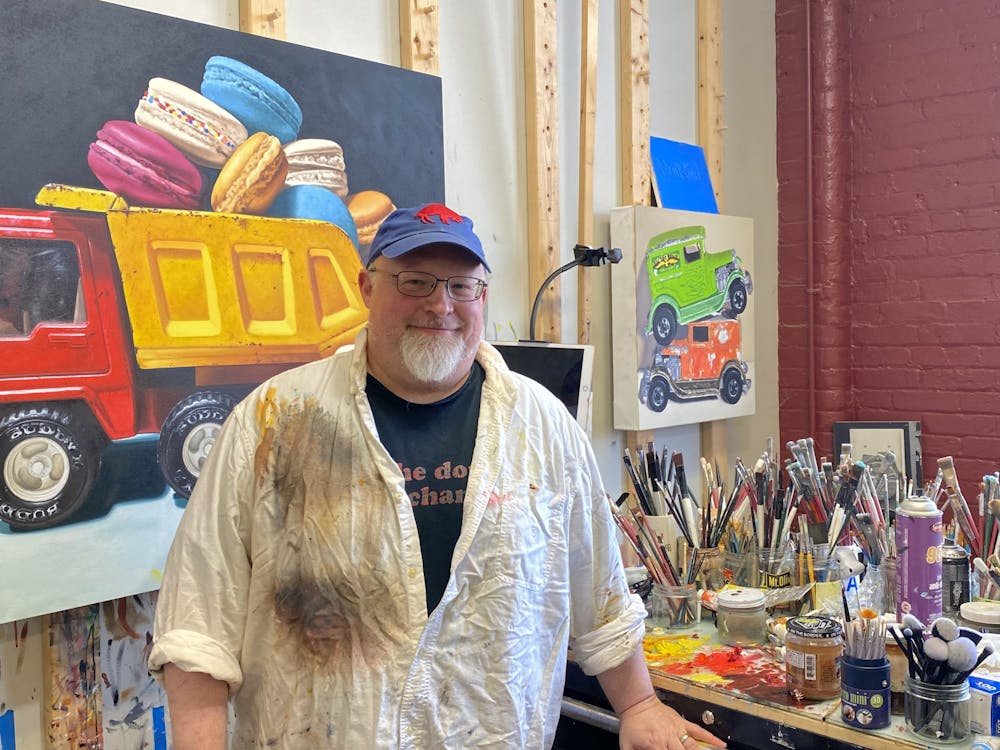Buffalo painter AJ Fries, known for his hyper-realistic paintings and bold personality, isn’t afraid of criticism.
If anything, he embraces it.
When Fries’ work was previously criticized for being too edgy at a gallery show, the local artist didn’t have a single complaint.
“The gallery said I was going to hell, and I was like, ‘Thank you! That’s the nicest thing you could say to me,’” Fries said. “You dislike my work so much that you don’t just seethe about it, you actually call a third person to say, ‘That artist is a piece of s—t.’ I am your piece of s—t! That’s flattering.”
While pushing the limits with his subject matter, one thing that always remains constant is his impeccably detailed paint textures.
His oil paintings of Fisher Price’s “Little People,” Monopoly figures and Twinkie packages charm viewers with nostalgia and tempt them to reach out and feel the familiar shapes. An element of shock emerges when these childlike paintings are contrasted with their adult counterparts: portraits of a different kind of toy.
Fries made countless pieces that play with this dichotomy, first creating combinations of a childhood toy and an adult toy. This was followed by a series of large paintings of coloring book images with sex toys on top.
“I wanted the sex toys to be big and shiny and in some way take the stigma away from them,” Fries said. “You know, go drive down any street — there’s probably one in every house. But oh my God, you can’t talk about it!”
The concept behind this collection was the feeling of desire.
“What I was putting forth is that it’s the same inner desire, but how it manifests and how it is satisfied is different,” Fries said. “It just changes as you get older.”
All his artwork — whether childlike, explicit or anything in between— connects to Fries’ main goal: sparking conversations.
“Art, culturally speaking, is low on the totem pole to the general public,” Fries said. “I want there to be any kind of reaction other than, ‘Oh, that’s cute.’”
Fries says that as long as he leaves an impression and gets people talking, he couldn’t care less about how audiences feel about his art.
“I’d rather be hated than ignored,” Fries said. “Ambivalence is the worst thing in the world.”
Fries’ art also celebrates the small joys of life. According to him, one of these joys is using a good curse word. He highlights his favorite word, “f—k,” in a painting where the four letters are spelled out in shiny, pink mylar balloons. Fries’ paintings honor powerful language and challenge society’s idea of what constitutes a “bad word.”
“I just love that word, f—k. I use it a lot. It’s every part of speech,” Fries said. “It’s positive, it’s negative. It’s awe-inspiring. It’s all these things, all in one simple word that’s supposed to be a bad word.”
Fries’ ode to expletives was highlighted in a 2016 series of paintings exploring taboo words with unique textures. The composition contains nothing but a pink or blue wet, glossy gel spelling out words like “c—k,” “prick,” “wang” and “c—t,” just to name a few. He specifically chose words that target masculine and feminine genitalia to play with differing perceptions. Fries again challenges his audience to face these words head-on and contemplate what really makes them so taboo.
“‘C—t’ is bad but ‘can’t’ isn’t,” Fries mused. “So what? It’s the vowel that makes it bad?”
Fries isn’t ashamed to admit that he’s imperfect — he’ll even make a massive painting honoring this fact. In a yet-to-be finished “self-portrait,” Fries painted the words “Mediocre White Guy” in plastic letter refrigerator magnets. Fries knows his work can’t please everybody, but showing respect is still always part of the job.
“I read a book about second-wave feminism called ‘C—t: A Declaration of Independence.’ I actually wrote to the author asking her what she thought about me doing this as a white, straight male,” Fries said. “She was just like, ‘F—king go for it.’”
“Go for it” he did, depicting the dirtiest of words in shiny, cursive gel.
No matter the subject, one constant in Fries’ work is the fascinating creation of texture. Even standing mere inches away from the canvas, it’s hard to believe the materials are made from nothing but paint. From rich desserts to vintage glassware to soapy bubbles, Fries has mastered the art of realism — though he doesn’t think so.
“I don’t think of myself as hyperrealist or even photorealist,” Fries explained. “The gallery that represents me, the artists there are blindingly better than me. I’m just banging rocks together compared to them.”
Fries continues to critique his own work as he strives to become flawless at his craft.
“It’s funny because I’m horrifically lazy. I try any shortcut I can,” Fries said. “It just turns out that the s–t I pick ends up having a bunch of texture, and I’m pissed at myself.”
The arts desk can be reached at arts@ubspectrum.com





